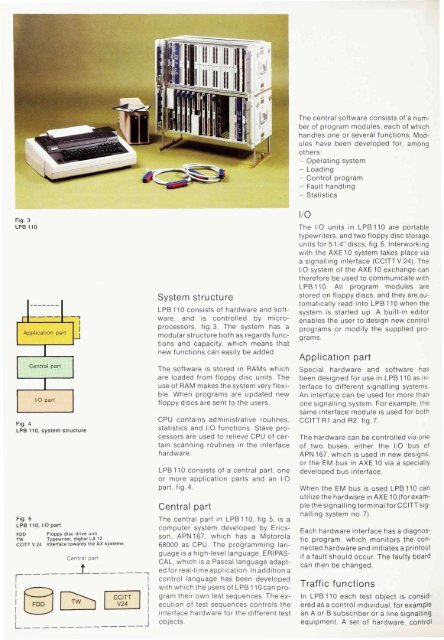TELE-X - a Satellite System for TV and Data Communication ...
TELE-X - a Satellite System for TV and Data Communication ...
TELE-X - a Satellite System for TV and Data Communication ...
You also want an ePaper? Increase the reach of your titles
YUMPU automatically turns print PDFs into web optimized ePapers that Google loves.
The central software consists of a number<br />
of program modules, each of which<br />
h<strong>and</strong>les one or several functions. Modules<br />
have been developed <strong>for</strong>, among<br />
others:<br />
- Operating system<br />
- Loading<br />
- Control program<br />
- Fault h<strong>and</strong>ling<br />
- Statistics<br />
Fig. 3<br />
LPB 110<br />
<strong>System</strong> structure<br />
LPB 110 consists of hardware <strong>and</strong> software,<br />
<strong>and</strong> is controlled by microprocessors,<br />
fig. 3. The system has a<br />
modular structure both as regards functions<br />
<strong>and</strong> capacity, which means that<br />
new functions can easily be added.<br />
The software is stored in RAMs which<br />
are loaded from floppy disc units. The<br />
use of RAM makes the system very flexible.<br />
When programs are updated new<br />
floppy discs are sent to the users.<br />
CPU contains administrative routines,<br />
statistics <strong>and</strong> I/O functions. Slave processors<br />
are used to relieve CPU of certain<br />
scanning routines in the interface<br />
hardware.<br />
LPB110 consists of a central part, one<br />
or more application parts <strong>and</strong> an I/O<br />
part, fig. 4.<br />
Central part<br />
The central part in LPB 110, fig. 5, is a<br />
computer system developed by Ericsson,<br />
APN167, which has a Motorola<br />
68000 as CPU. The programming language<br />
is a high-level language. ERIPAS-<br />
CAL, which is a Pascal language adapted<br />
<strong>for</strong> real-time app I i cat ion. In addition a<br />
control language has been developed<br />
with which the users of LPB 110 can program<br />
their own test sequences. The execution<br />
of test sequences controls the<br />
I/O<br />
The I/O units in LPB 110 are portable<br />
typewriters, <strong>and</strong> two floppy disc storage<br />
units <strong>for</strong> 51/4" discs, fig. 6. Interworking<br />
with the AXE 10 system takes place via<br />
a signalling interface (CCIT<strong>TV</strong>.24). The<br />
I/O system of the AXE 10 exchange can<br />
there<strong>for</strong>e be used to communicate with<br />
LPB 110. All program modules are<br />
stored on floppy discs, <strong>and</strong> they are automatically<br />
read into LPB 110 when the<br />
system is started up. A built-in editor<br />
enables the user to design new control<br />
programs or modify the supplied programs.<br />
Application part<br />
Special hardware <strong>and</strong> software has<br />
been designed <strong>for</strong> use in LPB 110 as interface<br />
to different signalling systems.<br />
An interface can be used <strong>for</strong> more than<br />
one signalling system. For example, the<br />
same interface module is used <strong>for</strong> both<br />
CCITTR1 <strong>and</strong> R2, fig.7.<br />
The hardware can be controlled via one<br />
of two buses, either the I/O bus of<br />
APN 167, which is used in new designs,<br />
or the EM bus in AXE 10 via a specially<br />
developed bus interface.<br />
When the EM bus is used LPB 110 can<br />
utilize the hardware in AXE 10 (<strong>for</strong> example<br />
the signal ling terminal <strong>for</strong> CCITT signalling<br />
system no. 7).<br />
Each hardware interface has a diagnostic<br />
program, which monitors the connected<br />
hardware <strong>and</strong> initiates a printout<br />
if a fault should occur. The faulty board<br />
can then be changed.<br />
Traffic functions<br />
In LPB 110 each test object is considered<br />
as a control individual, <strong>for</strong> example
















